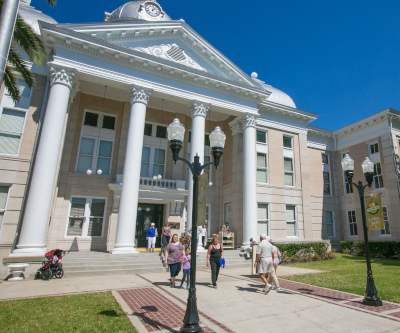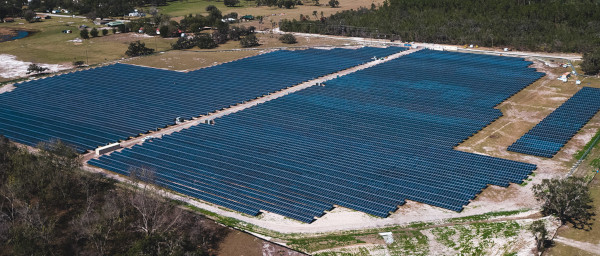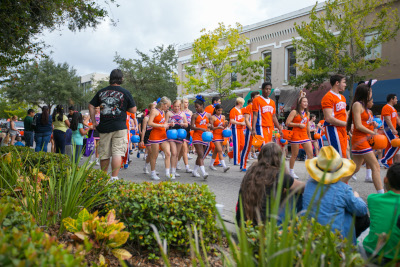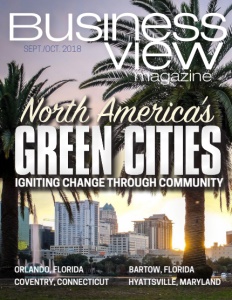Bartow, Florida
Room to grow
Business View Magazine interviews representatives of Bartow, Florida, as part of our focus economic development of American cities.
Bartow, Florida, the county seat of Polk County, is located in the central part of the state, midway between the metropolitan areas of Orlando and Tampa. The town was originally founded in 1851 as Fort Blount, but was renamed in 1862, in honor of Francis S. Bartow, the first brigade commander of the Confederate Army to die in combat during the American Civil War.
 Bartow, Florida incorporated as a city in 1882, and in 1885, the Florida Southern Railroad, a north-south route from North Florida to Southwest Florida opened in the town. A year later, the Bartow Branch of the South Florida Railroad, connecting Tampa and Orlando, was completed. The railroads were catalysts for growth of the area, and during the Spanish–American War, the Bartow rail yards became a crucial part of the supply line directed at US troops in Cuba. By the turn of the century, Bartow had become the most populous city south of Tampa on the Florida peninsula.
Bartow, Florida incorporated as a city in 1882, and in 1885, the Florida Southern Railroad, a north-south route from North Florida to Southwest Florida opened in the town. A year later, the Bartow Branch of the South Florida Railroad, connecting Tampa and Orlando, was completed. The railroads were catalysts for growth of the area, and during the Spanish–American War, the Bartow rail yards became a crucial part of the supply line directed at US troops in Cuba. By the turn of the century, Bartow had become the most populous city south of Tampa on the Florida peninsula.
In the early 1900s, the area around Bartow, Florida became the hub of the phosphate industry in the United States. “From an historical standpoint, it’s been all about phosphate,” says City Planner, Bob Wiegers. “Over the years, the phosphate companies have merged, and come and gone, but there’s been phosphate mining going on in this area since the 1920s. Today, the major driver in the local area is a company called Mosaic. Mosaic doesn’t necessarily mine in and around Bartow, anymore, because a lot of the area is already mined out. But it’s still mining to the south of us and the west of us and they still bring a lot of the mined ore through Bartow to their processing plant which is just west of town. So, it’s still phosphate mining, but from an industrial standpoint.”
Citrus farming and cattle ranching were also important parts of the city’s livelihood, but perhaps the most dominant force in the economy of Bartow, today, is city, county, and state government. As the capital of a county with over 650,000 people, Bartow has an unusually large number of government jobs. In addition to city and county offices, there is also a number of regional, state, and federal offices located within the city limits. Nine of the 17 largest employers in Bartow, Florida are government entities. The largest by far is the Polk County School Board with over 12,000 employees. Other county entities which employ many people in the Bartow area include the County Commission, the Sheriff’s Office, the Clerk of Courts, the Tax Collector, and the Property Appraiser. The Florida Department of Transportation District One office is located in Bartow and is responsible for southwest Florida’s transportation needs.
Bartow, Florida’s current population is about 18,300, and for many years, the city grew slowly because, unlike a few of its nearby cities, such as Lakeland and Winter Haven, Bartow has had little land available for residential development, as much of the area was still devoted to mining and agriculture. “The other thing that affects us is Interstate 4, which goes from Tampa all the way to Daytona Beach and that’s the big growth corridor,” Wiegers adds. “So, there are a lot of communities in Polk County that are recipients of a tremendous amount of growth because of being close to I-4. We’re not close enough to get a lot of benefit. We’re not a commuter town from inside/outside; we get a lot of commuters, outside/in.”
That, however, is beginning to change, with the annexation of approximately 40 square miles over the last two decades which the city is planning to utilize for residential, commercial and industrial, as well as additional recreational and open space opportunities. “The biggest player on the block is a company called Clear Springs,” says Wiegers. “Its project area is roughly 17,500 acres, which is almost 28 square miles.”
Clear Springs is former phosphate land which was bought in 1999 by Stanford Phelps, a financier from Connecticut. Plans for the future development of Clear Springs include agriculture operations, focused on cattle ranching and the production of blueberries, strawberries, and grape tomatoes; a corporate research park; over a million square feet of commercial and industrial space; three schools; a golf course; and more than 11,000 homes. Wiegers reports, however, that those ambitious plans have stalled, somewhat, due to the Great Recession. “It’s unfortunate that it hasn’t progressed faster because it kind of came about when the market was in a downturn, back in 2007-08, and it’s still kind of finding its way out of that,” he says. “At this point, we’ve got a lot on paper, but very little of it has been built.”

Bartow Solar Farm
Rob Clancey, Executive Director of the Bartow Economic Development Council, is optimistic, though, that Clear Springs will finally begin to take off within a few years. “The Department of Transportation has just laid out new plans to extend the Polk Parkway, which connects to I-4, to bring it down on the east side of Bartow, very close to the Clear Springs properties,” he explains. “When that happens – between 2022 and 2025 – that’s when Clear Springs is going to make its big move to start marketing. That will be real, major growth for us.” In fact, when the buildout of the Clear Springs Development is completed by 2030, the population of Bartow is projected to be over 45,000 residents.
Meanwhile, part of Bartow’s current strategic plan includes revitalization of its downtown core. “We do have funding available that allows for rehab or restoration of some buildings,” says Stephen Cox, Executive Director of the Bartow Community Redevelopment Agency (CRA). “We’ve been working with the property owners to try and get some movement. There’s been a lot of stagnant ownership and a lot of second and third generation owners who haven’t been investing in their property. In recent years, we also put a lot of focus on residential, and we’ve been trying to create housing in the area. We’ve had a number of vacant parcels that we’ve identified and are trying to acquire, and we’re trying to incentivize builders to come in and build new homes.”
Other aspects of Bartow’s incipient renaissance include a complete renovation of its high school, first build in the 1950s, and the appearance of several new businesses. “We’re getting a Starbucks, and a Waffle House broke ground, last week,” says Jeff Clark, Executive Director of the Greater Bartow Chamber of Commerce. “A lot of retail, restaurants, and chains are looking at us. And we’ve seen an uptick in the past year of new mom-and-pop shops, downtown, and it’s been exciting to see that happen.”
Clancey adds that HPP Fresh Florida, a company that uses high pressure to preserve food without the use of chemicals, has just opened its new plant in Bartow. The facility represents a $7.7 million investment in the building and equipment, and has produced 20 new jobs.
Bartow is also planning to expand its role as a provider of electrical power for itself and its surrounding customer service area. “The city has been a provider of electrical service since the early 1900’s,” says Wiegers. “We wholesale it from others who generate it and resell it to customers through our distribution lines. So, we’ve always been in the power business, and our City Commission had the vision to take into consideration the opportunity to incorporate some renewable energy into our energy programs.”
We did a partnership with a group out of Orlando called NovaSol and developed 40 acres worth of photovoltaic generation capabilities that will directly benefit Bartow, Florida residents,” he continues. “It’s capable of generating about seven megawatts a day. In addition to that, we’ve also recently worked on two large photovoltaic sites with Tampa Electric Company with each one of them capable of generating about 55 megawatts of power. They will use them to feed into their transmission and distribution system throughout Central Florida. While we’re not directly going to be a customer, currently, we’re working on some ideas as to how that might benefit us in the future, as well. So, it’s been an interesting transition. We are in the solar business and we’re hopeful that it’s going to be a tremendous benefit for us.”
When asked about Bartow, Florida’s future, Wiegers says that he wants to see continued redevelopment of the city’s core area and more businesses coming into the community, so that residents don’t have to go elsewhere for their shopping and social needs. “We don’t even have a movie theater in Bartow and we don’t have a bowling alley,” he opines. “And a lot of times that’s one of the things we hear: ‘Why don’t we have it?’ My typical response is, ‘We don’t have enough people.’ Our daytime population is huge because of all the service sector employees associated with the government facilities in the City, but everybody goes home at night and from a planning perspective, that’s what I want to see in five years – additional businesses in the community, so we don’t have to drive to them.”
Clark agrees. “For so long, we’ve lost a lot of our young people,” he states. “They go to college and they move off. If we’re going to grow and attract those people back here, we’ve got to get some more industry and increase our business community. And that’s what we’re beginning to see, now. I’m excited because there seems to be a lot of interest in Bartow that I haven’t ever seen before and I’ve lived here my whole life. I think Bartow, Florida is a very unique community; it has a hometown feel and I’d like to see it grow, but not so big that it’s out of control. I think we’ve got the right mix here. We’ve got a strong community and we’ve got a lot of opportunity in the near future.”
“We’ve got to keep the small town feeling, but we’ve got to add panache like the micro-brewery and one or two restaurants,” Clancey adds. “It’s all going to come together; people are going to want to live here, work here, and play here. We’re working on all of those aspects right now. To me that’s more important than having a big industry down the street.”
 Cox says, “What I would like to see in the next five years is a continuation of what we’ve been doing. The Chamber, the city, the CRA – we’ve been working very hard to get on the same page to create an atmosphere that is welcoming to the business community, an atmosphere where houses can be built and renovated to provide homes for families, but also the working environment that will be sustainable for years to come. The idea is that if you can provide the jobs, then the majority of people will decide to live here. Every time we get one or two families that decide, instead of commuting from Lakeland or Winter Haven to Bartow every day, to live here, that’s a good thing. We want to facilitate that by having a good relationship with businesses, investors, and developers and to make sure that when they come to any of us, we can give them the right information to smooth the process for redevelopment.”
Cox says, “What I would like to see in the next five years is a continuation of what we’ve been doing. The Chamber, the city, the CRA – we’ve been working very hard to get on the same page to create an atmosphere that is welcoming to the business community, an atmosphere where houses can be built and renovated to provide homes for families, but also the working environment that will be sustainable for years to come. The idea is that if you can provide the jobs, then the majority of people will decide to live here. Every time we get one or two families that decide, instead of commuting from Lakeland or Winter Haven to Bartow every day, to live here, that’s a good thing. We want to facilitate that by having a good relationship with businesses, investors, and developers and to make sure that when they come to any of us, we can give them the right information to smooth the process for redevelopment.”
“I want to do it all,” says Wiegers. “I want to see us continue increasing the opportunities to do everything – housing, redevelopment in our neighborhoods, trying to make the city a more attractive place. Over the years, we’ve gotten a good reputation for dealing with people fairly and honestly, and it’s starting to pay dividends for us; it’s resulted in some good quality development here. There’s a good future for Bartow. As long as we can manage it and balance it, it’s going to result in a great return.”
Check out this handpicked feature on The Bartow Municipal Airport – A history of pilot training.
AT A GLANCE
WHO: Bartow, Florida
WHAT: A city of 13,000
WHERE: Central Florida, midway between Orlando and Tampa
WEBSITE: www.cityofbartow.net
PREFERRED VENDORS
Orlando Utilities Commission – www.ouc.com
The Orlando Utilities Commission (OUC) is a municipally-owned public utility providing water and electric service to the citizens of Orlando, Florida and portions of adjacent unincorporated areas of Orange County, as well as St. Cloud, Florida, in Osceola County. Established in 1923 by a special act of the Florida Legislature, OUC is the second largest municipal utility in Florida and the 14th largest municipal in the country. OUC provides electric, water, chilled water and/or lighting services to more than 240,000 customers
OUC owns and operates the Curtis H. Stanton Energy Center in east Orange County. The most diverse generating site in the state, natural gas, landfill methane gas, coal, and solar are on the 3,280 acre property, which can generate more than 1,800 megawatts of electricity. OUC also owns the Indian River Plant near Cocoa, a 40 percent ownership of Lakeland Electric’s McIntosh Unit 3 in Lakeland, and a six percent stake of the St. Lucie Nuclear Power Plant near Ft. Pierce. OUC also owns and operates seven water plants and a distribution network of more than 1,700 miles of pipe. OUC’s water is pumped from the Lower Floridan Aquifer and treated with ozone to reduce the need for other chemicals.


2 comments
[…] Check out this handpicked feature on Bartow, Florida – Room to grow. […]
[…] Check out this handpicked feature on Bartow, Florida – Room to grow. […]
Comments are closed.